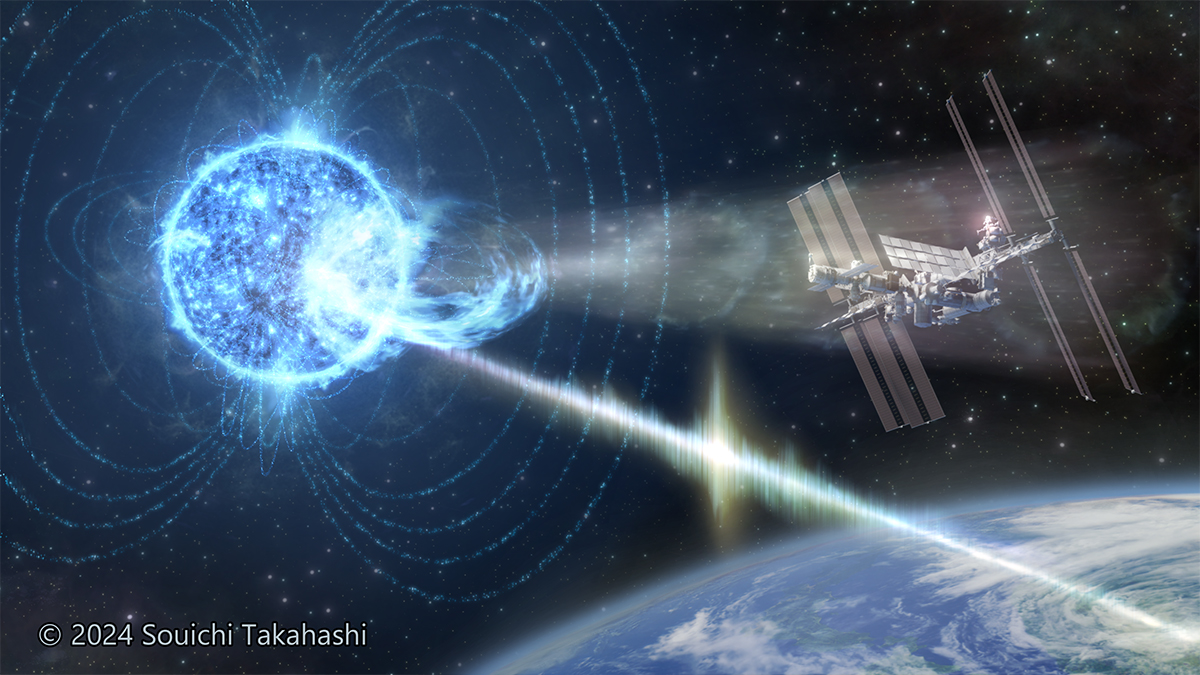New clues to mysterious radio signals from deep space
Thanks to two NASA X-ray telescopes, an international team of scientists involving the Toulouse-based Institut de Recherche en Astrophysique et Planétologie (IRAP/OMP – CNES/CNRS/UT3) has been able to observe a magnetar emitting fast radio bursts. Their analysis provides a better understanding of how these brief – but intense – bursts of radio waves are formed, gradually revealing their secrets. The study, co-authored by Sébastien Guillot, assistant astronomer at Toulouse’s Paul Sabatier University, was published in the journal Nature on February 14.
Capable of projecting as much energy in the form of a pulse of radio waves in a few milliseconds as the Sun does in a year, fast radio bursts have been stirring the scientific community since their discovery in 2007. Their short duration makes it difficult to pinpoint their origin, which is usually at the very edge of the universe, outside our own galaxy. This in turn complicates our understanding of the formation of this phenomenon.
But everything changed in 2020, when one of these fast radio bursts was detected… within the Milky Way itself! The signal came from the remains of a star at the end of its life cycle, a magnetar called SGR 1935+2154. NASA’s NICER and NuSTAR X-ray telescopes were pointed in its direction to observe these mysterious, repetitive events “live”. This unprecedented view enabled scientists to study the surface of the source object and its immediate surroundings, paving the way for a better understanding of these extreme radio phenomena.
In October 2022, this same magnetar produced another fast radio burst, fully captured by the telescopes. The observatories involved in the study studied the magnetar for hours, revealing behavior never before recorded. The burst occurred between two glitches, abrupt changes in the magnetar’s rotation.

The astronomers found that the magnetar suddenly began to spin faster, requiring a significant amount of energy to change its rotational speed. The study authors were surprised to find that between glitches, the magnetar slowed down to a speed lower than its preglitch speed in just nine hours, a deceleration 100 times faster than previously observed in a magnetar after a glitch. “Such a change in rotation also enables us to better understand the internal composition of this object, which necessarily contains a large fraction of superfluid material”, explains Sébastien Guillot, assistant astronomer at IRAP.
Given their high internal density, the strength of their gravitational field, and the intensity of their magnetic field, scientists are seeking to understand how magnetars manage to produce fast radio bursts. Prior to the 2022 fast radio burst, the magnetar had begun to emit X-ray and gamma-ray flares, prompting astronomers to point NICER and NuSTAR directly at this highly active cosmic object.
This discovery was only possible “thanks to satellite observations made several times a day over a two-week period. Unfortunately, at the exact moment of the fast radio burst, the magnetar was occulted by the Earth, so we were unable to observe it”, explains Sébastien Guillot. “We are continuing to investigate these mysterious radio bursts by making simultaneous observations with radio telescopes and NICER.”
The next step in our quest to unravel the mysteries surrounding these radio bursts is the Franco-Chinese SVOM mission. Its objective is to study the most distant stellar explosions, gamma-ray bursts, but its instruments can also be used to observe fast radio bursts. Scheduled for launch in June, one of the mission’s devices was partly developed at IRAP.
Further Resources
- Scientific article : Rapid spin changes around a magnetar fast radio burst by Chin-Ping Hu, Takuto Narita, Teruaki Enoto, George Younes, Zorawar Wadiasingh, Matthew G. Baring, Wynn C. G. Ho, Sebastien Guillot, Paul S. Ray, Tolga Güver, Kaustubh Rajwade, Zaven Arzoumanian, Chryssa Kouveliotou, Alice K. Harding & Keith C. Gendreau, Nature, 14 février 2024.
- Press Releases :
- De nouveaux indices pour comprendre des mystérieux signaux radio provenant de l’espace lointain (Université Paul Sabatier de Toulouse)
- NASA Telescopes Find New Clues About Mysterious Deep Space Signals (NASA)
- Press Review :
- Un sursaut radio rapide observé pile entre 2 glitchs d’un magnétar (Ca se passe là-haut)
- Dead star ‘glitches’ could reveal the origins of fast radio bursts (Space.com)
- Another Clue Into the True Nature of Fast Radio Bursts (Universe Today)
IRAP Contact
- Sébastien Guillot, Sebastien.Guillot@irap.omp.eu






